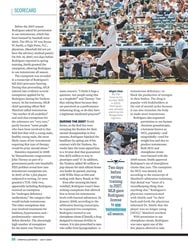
The Case for ... 30 As The New 20
DATING TO HIS time as a top junior tennis player, Grigor Dimitrov has been blessed—which is to say, cursed—with the title of "the next Federer." A righty from Bulgaria, Dimitrov plays with the same casual elegance as Federer (right), hits a nearly identical one-handed backhand and even bears a slight resemblance to the man atop tennis's Mount Olympus. Currently No. 13 in the rankings, Dimitrov is getting the star-in-ascent treatment. He was recently accorded a generous deal from Nike. He is all over the ATP's marketing material. And at Wimbledon he was assigned to Centre Court and drew sizable crowds eager to catch the sport's Next Big Thing.
It's tempting to call him a young star, but that's not entirely accurate. While Dimitrov's career is just starting to gain altitude, he's already 23, older than, say, Kawhi Leonard and Mike Trout. But this is what it's come to in tennis. A quarter century ago Michael Chang won the French Open as a 17-year-old. Pete Sampras won his first Grand Slam title the next year, at 19. Today? There are no teenagers in the ATP's top 100. And the youngest player in the Wimbledon draw with a Slam to his name is Novak Djokovic, who's 27.
"Thirty is the new 20" could be the mantra of the women's draw as well. Those ferocious, precocious teenagers who won big titles before they were eligible for learner's permits? They are an extinct species. The top two Wimbledon seeds—Serena Williams and Li Na—were both 32. And they are more than a decade junior to colleague Kimiko Date-Krumm, who, at age 43, lost in the first round but vowed to return next year.
The reasons for the graying of the field are many, but most obviously the sport has become so physically demanding that full body (and emotional) maturity is an occupational requirement. When Tracy Austin won the 1979 U.S. Open as a 16-year-old, she weighed 90 pounds, roughly the size of a contemporary player's leg.
More important than the cause is the effect, and the mature workforce is to the sport's benefit. Tennis no longer has to deal with the ugliness (and bad publicity) that comes with young stars and prepubescent millionaires. Burnout cases, overbearing parents and public acts of rebellion—Capriati-itis, the affliction was shorthanded—are in sharp decline. Instead, there now exists on tour a cohort of thoughtful and self-possessed adults who, say, host pretournament charity benefits as Venus Williams did or, in the case of Andy Murray, 27, have the maturity to hire a woman as a coach.
What's more, tennis careers are spanning a longer bridge of time. In the same way that Yankees fans truly connect with Derek Jeter, who was drafted at 17 and is playing his final season this year at age 40, tennis fans get the full sports life cycle of their favorite players. We've seen Williams, for instance, evolve from a brash arriviste, to a champion in the meat of her career, to the dignified veteran she is today at age 34.
True, the absence of youth deprives tennis of a desirable demographic. True, the sport probably suffers in social media popularity. And, yes, there's been a drop in attention-getting melodrama and tantrums and arrested development. But the sport is hardly without high jinks. Last week Ivo Karlovic of Croatia lost his first round match and promptly took to Twitter to express his frustration, issuing the tweet:
"If you can't win on it, smoke it ... #grassseason"
Were Karlovic a teenage phenom still finding his way in the world, this would've been perceived as a cry for help and triggered all sorts of alarms from agents and handlers. But coming as it did from a 35-year-old man, it simply made for humor—juvenile, to be sure.
There now exists on tour a cohort of thoughtful and self-possessed adults
8
Years since a teenager, male or female, has won a Grand Slam event, the longest drought in the Open Era.
0
Teenagers to finish the year ranked No. 1 this century.
PHOTO
DAVID CALLOW FOR SPORTS ILLUSTRATED

